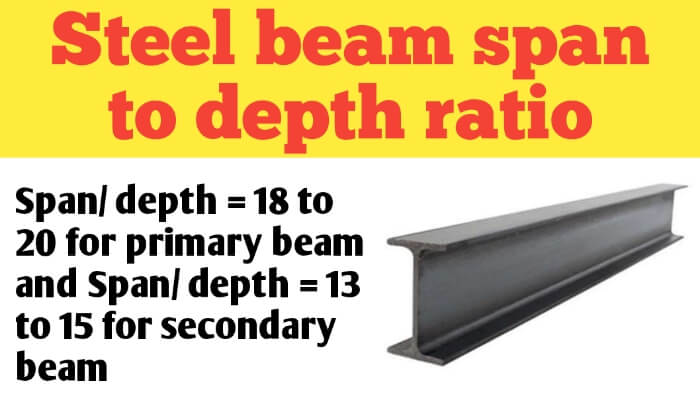The span length to depth ratio of a steel beam is an important consideration in structural engineering and design. It helps determine the beam’s ability to support a load over a given span while maintaining structural integrity. The specific ratio can vary depending on the type of steel beam, its intended use, and local building codes. In general, a higher span-to-depth ratio indicates a longer span for a given depth, which can lead to greater deflection and reduced load-carrying capacity.
The depth-to-span ratio for steel beams depends on several factors. However, as a general guideline, a common rule of thumb is to aim for a depth-to-span ratio is 1/24 for roof beam or roof joist, 1/20 for floor beam or floor joist, 1/22 composite beam, 1/18 to 1/20 for primary beam, 1/13 to 1/15 for secondary beam and between 1/15 and 1/20 for simply supported beams.
There is a different kind of frame structure are made with the help of hot rolled section of steel such as open section of steel i beam (universal beam), H beam (universal column), W beam (universal column with wide flange), some are hollow section, tube section and closed circular, rectangular or square shaped section of steel.
Tension member and flexural member of framework all are design and connected in different way such as braced frame or simple construction in which beam and column are designed to be resist only vertical load and their connection are designed to normally pinned. Rigid or continuous frame in which frame structure design to resist moment also and the Arch structure in which forces are transfer to the ground by compression within the structure and tension structure in which forces are transfer to ground by tension.
Steel beam is also known as Universal beam or UB’s or I beam or H beam, W beam, rolled steel joist, double T due to their shape. Steel beam are very versatile and can be used in various structural Steel construction project. It is consist of two horizontal plates known as flanges connected by vertical component known as web. Generally depth of Universal beam or steel beam is greater than their width which makes them suitable for beam application where strength needs to be in one of direction. Which is the most often used section for structural Steel purpose.
Steel beam or universal beam are extremely effective for use as structural Steel. they provide the maximum amount of strength for the volume of Steel used in making them the most efficient method of carrying bending and shear loads. In this artical you know about Steel beam span length to depth ratio, steel beam depth to span ratio, span to depth ratio for steel beam, span to depth ratio for steel primary beam and span to depth ratio for secondary steel beam according to Thumb Rule and experience basis.
There is different shape and size of hot rolled Steel section such as H beam (universal column), I beam (universal beam), angles, channels and etc are used in construction project such as field of agriculture construction, industrial construction, multi storey building, different factories and residential projects. Today is the demand of steel structure in the field of construction projects that replace the depending on reinforced cement concrete, their higher strength, less time consuming, make it ideal for residential project in short duration.
Primary beam is type of horizontal flexural (beam) structure member which directly connected to supporting compressive structure member that is column. It is also known as main beam which safely transfer the load to the column acting on it by the slab or by secondary beam if it is present.
Secondary beam is type of horizontal flexural (beam) structure member which directly connected to primary beam and not connected directly to column. It is known as secondary beam which safely transfer the load to the primary beam acting on it by the roof slab.
◆You Can Follow me on Facebook and
Subscribe our Youtube Channel
Steel beam span length to depth ratio | steel beam depth to span ratio
Span to depth ratio (or span/ depth ratio, which is also known as slenderness ratio L/H) is the ratio of the span length of beam divided by the depth or vertical height of a component. Beams are designed to resist bending moment and shear forces the shape of hot rolled section are designed to achieve optimum bending properties to the use of Steel.

Formula for span to depth ratio for steel beam are represented as Span/ depth or L/h = 18 to 20 for primary steel beam which are directly connected to supporting compressive structure member that is universal column and L/h = 13 to 15 for secondary steel beam which directly connected to primary beam and not connected directly to the universal column.
Steel beam depth to span ratio:- Steel beam which are scheme design of uniformly loaded section of Steel, hot rolled section with a span to depth ratio is 18 to 20 are typically used for primary steel beam which are directly connected to the universal column and 13 to 15 span to depth ratio are typically used for secondary steel beam which are directly connected to the primary universal beam.